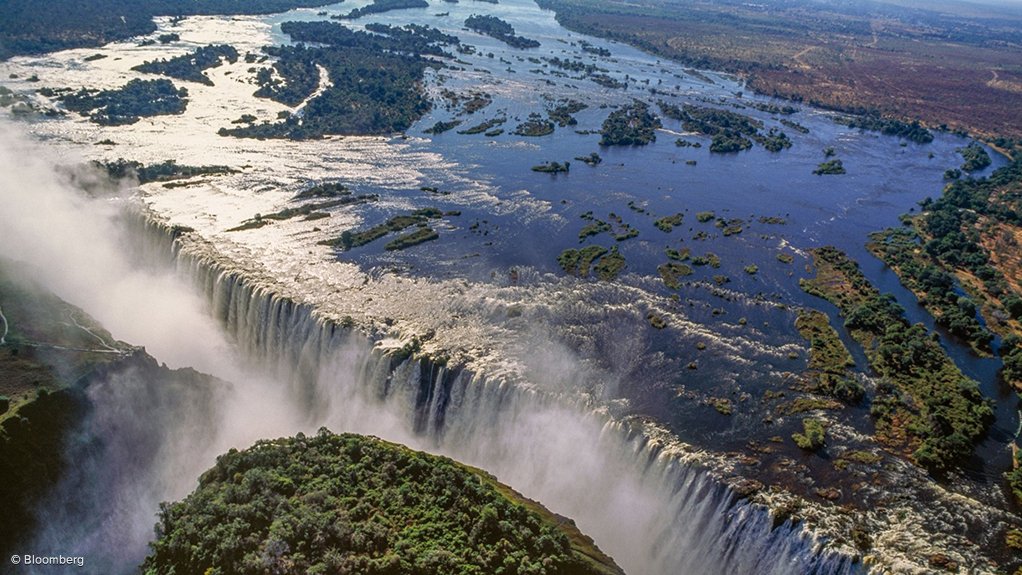Tourism, energy at risk as Africa's largest waterfall runs low
The flow at the Africa’s biggest waterfall is at its lowest since 1995, highlighting the threat posed by a drought to tourism and electricity generation in Zimbabwe and Zambia.
Flow has slumped to 109 m3/s at Victoria Falls, a 1.7 km curtain of falling water at the peak of a normal wet season, according to the Zambezi River Authority. The falls on the Zambezi river straddle the border between Zimbabwe and Zambia and the flow of the watercourse fills the Kariba dam, the site of the two countries’ largest power plants.
The drought threatens to deter tourists from visiting the site, could curtail a lucrative white-water rafting industry in the gorge below the cataract and may see the power plants at Kariba shut down, worsening power cuts in both countries. Elephants at nearby game parks are dying of hunger, further damaging the tourism industry.
“Some of the tourism products that we boast of can be a thing of the past if climate change and global warming are not quickly addressed,” said Godfrey Koti, a spokesperson for the Zimbabwe Tourism Authority.
Key among Victoria Falls’ attractions is a rain-forest fed by the spray of the thundering waters. That spray gives Victoria Falls’ its local name – Mosi Oa Tunya – The Smoke That Thunders.
“Rafting activities and visits to the rain-forest have declined,” said Clement Mukwasi, president of the Employers Association for Tourism and Safari Operators. “There isn’t much that we can do except for us as an industry to promote awareness of climate change.”
The flow at the falls is volatile. The lowest on record is 99 m3/s in October 1996, while the record is m3/s in April 1977, according to the authority.
This year’s paucity, which has left Kariba 15% full, has already cut power generation at the Zimbabwean plant to just over a tenth of its usual output.
”We are dangerously close to a level where we have to cut off power generation," Mthuli Ncube, Zimbabwe’s finance minister, told lawmakers in Victoria Falls town on Thursday.
Rains in Zimbabwe normally begin in November and end around April.
Article Enquiry
Email Article
Save Article
Feedback
To advertise email advertising@creamermedia.co.za or click here
Comments
Press Office
Announcements
What's On
Subscribe to improve your user experience...
Option 1 (equivalent of R125 a month):
Receive a weekly copy of Creamer Media's Engineering News & Mining Weekly magazine
(print copy for those in South Africa and e-magazine for those outside of South Africa)
Receive daily email newsletters
Access to full search results
Access archive of magazine back copies
Access to Projects in Progress
Access to ONE Research Report of your choice in PDF format
Option 2 (equivalent of R375 a month):
All benefits from Option 1
PLUS
Access to Creamer Media's Research Channel Africa for ALL Research Reports, in PDF format, on various industrial and mining sectors
including Electricity; Water; Energy Transition; Hydrogen; Roads, Rail and Ports; Coal; Gold; Platinum; Battery Metals; etc.
Already a subscriber?
Forgotten your password?
Receive weekly copy of Creamer Media's Engineering News & Mining Weekly magazine (print copy for those in South Africa and e-magazine for those outside of South Africa)
➕
Recieve daily email newsletters
➕
Access to full search results
➕
Access archive of magazine back copies
➕
Access to Projects in Progress
➕
Access to ONE Research Report of your choice in PDF format
RESEARCH CHANNEL AFRICA
R4500 (equivalent of R375 a month)
SUBSCRIBEAll benefits from Option 1
➕
Access to Creamer Media's Research Channel Africa for ALL Research Reports on various industrial and mining sectors, in PDF format, including on:
Electricity
➕
Water
➕
Energy Transition
➕
Hydrogen
➕
Roads, Rail and Ports
➕
Coal
➕
Gold
➕
Platinum
➕
Battery Metals
➕
etc.
Receive all benefits from Option 1 or Option 2 delivered to numerous people at your company
➕
Multiple User names and Passwords for simultaneous log-ins
➕
Intranet integration access to all in your organisation

















